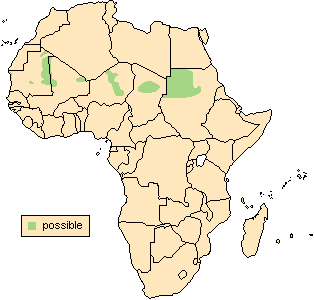![]() Return
to Artiodactyla
Return
to Artiodactyla
Classification
|
 Addax
nasomaculatus
Addax
nasomaculatus
Addax
![]()
Taxonomy
 |
 |
 |
Click on the images above for a larger view of the
photographs
|
||
General Characteristics
Body Length: 110-130 cm / 3.6-4.3 ft.
Shoulder Height: 95-115 cm / 3.1-3.8 ft.
Tail Length: 25-35 cm / 10-14 in.
Weight: 60-125 kg / 132-275 lb.The short, glossy coat is off-white to pale grayish brown in colour, being generally lighter in the summer and darker in the winter. The rump, underparts, limbs, and lips are pure white. There is a white 'X'-shaped blaze on the face, and a mat of dense, dark hair on the forehead. Long hairs on the throat form a scraggly beard. The spiraled horns are found in both sexes, growing 60-109 cm / 2-3.6 feet long in males and 55-80 cm / 1.8-2.6 feet long in females. The wide hooves have flat soles and may be spread widely, which, along with the well-developed dewclaws, prevent the oryx from sinking in sand.
Ontogeny and Reproduction
Gestation Period: 8.5 months.
Young per Birth: 1
Weaning: At 3.5 months.
Sexual Maturity: Females at 1.5 years, males at 3 years.
Life span: Up to 19 years.The reddish brown young are born primarily in winter and spring, although captive observations indicate that birth may occur throughout the year.
Ecology and Behavior
The addax is most active from dusk until dawn, the coolest time (night) in the Sahara. To protect themselves from strong winds and the glaring sun during the day, addax dig 'beds' into the sand with their forefeet in which they rest, often in the shade of boulders or bushes. A nomadic species, this antelope wanders the dunes of the Sahara searching for the scant vegetation which grows there. The addax is able to obtain all needed moisture from its food, and rarely - if ever - drinks water. Males leave small piles of fecal matter, while females reportedly scatter their dung. Addax live in small herds with a distinct social hierarchy, seemingly based on age.Family group: Mixed herds with 2-20 individuals (formerly more), led by an old male.
Diet: Grasses, herbs, leaves on small bushes.
Main Predators: Formerly lion, leopard, hyena (these have been generally exterminated).
Distribution
Isolated patches in the Sahara desert.

Range Map (Redrawn from IEA, 1998)
Conservation Status
The addax is classified as endangered by the IUCN (1996).
Remarks
Addax (Latin) a wild animal with crooked horns (from an African word). Nasus (Latin) the nose; macula (Latin) a spot; -atus (Latin) suffix meaning provided with: a reference to the bridle-like facial markings.
Literature Cited
IEA (Institute of Applied Ecology). 1998. Addax nasomaculatus. In African Mammals Databank - A Databank for the Conservation and Management of the African Mammals Vol 1 and 2. Bruxelles: European Commission Directorate. Available online at http://gorilla.bio.uniroma1.it/amd/amd147b.htmlKingdon, J. 1997. The Kingdon Field Guide to African Mammals. Academic Press, London and New York: NaturalWorld.
Nowak, R. M. [editor]. 1991. Walker's Mammals of the World (Fifth Edition). Baltimore: The Johns Hopkins University Press.
Walther, F. R. 1990. Roan and Sable Antelopes. In Grzimek's Encyclopedia of Mammals. Edited by S. P. Parker. New York: McGraw-Hill. Volume 5, pp. 437-447.
Wilson, D. E., and D. M. Reeder [editors]. 1993. Mammal Species of the World (Second Edition). Washington: Smithsonian Institution Press. Available online at http://nmnhwww.si.edu/msw/
Return to Artiodactyla

![]()
© Brent Huffman, www.ultimateungulate.com |
|
|